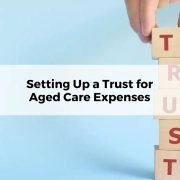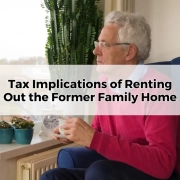Complex Home Ownership Arrangements
Table of Contents
ToggleHomeownership arrangements are not always simple. They may not involve a single person or a couple owning the family home. Other homeownership arrangements can change the Centrelink/DVA and aged care assessments of the family home.
The Home is Owned and Occupied with Someone Other Than a Spouse
A client may own and occupy their home with someone who is not their spouse. When the client owns a share (percentage) of their home, their assessment is measured on their share of that home.
Assessment for Centrelink/DVA
The two-year rule applies. The client’s share of the home will be exempt for two years from the date they enter a care situation. They will be assessed as a homeowner. After two years, the client’s share of the home will be assessed at net market value, and they will be assessed as a non-homeowner. The other party’s share of the home will not impact the client’s assessment. Any net rental income is assessable with no exemption period. For clients in severe financial hardship, if the joint owner refuses to sell the home, financial hardship provisions may be available, subject to eligibility criteria.
Assessment for Aged Care
The client’s share of the home will be assessed at up to the capped value. This applies unless the joint owner is a protected person and remains in the home (i.e., carer or close family member meeting the conditions). If they are a protected person, the home remains exempt. Any net rental income is assessable with no exemption period. For clients in severe financial hardship, if the joint owner refuses to sell the home, financial hardship provisions may be available, subject to eligibility criteria.
A Former Spouse Lives in the Home
A client may own and occupy their home with a former spouse. Clients in an estranged relationship may not be assessed as a couple but will be treated as couples living separately under one roof. This means they are assessed as two single individuals and are not eligible for spouse exemptions.
Reassessment for Centrelink/DVA
The two-year rule applies. The client’s share of the home will be exempt for two years from the date they enter a care situation. They will be assessed as a homeowner. After two years, the client’s share of the home will be assessed at their net market value, and they will be assessed as a non-homeowner. The former spouse’s share of the home will not impact the client’s assessment. Any net rental income is assessable with no exemption period. For clients in severe financial hardship, if the former spouse is refusing to sell the home, financial hardship provisions may be available, subject to eligibility criteria.
Reassessment for Aged Care
The client’s share of the home will be assessed at up to the capped value. This applies unless the former spouse can qualify as a protected person using the carer provisions. If they are a protected person, the home remains exempt. Any net rental income is assessable with no exemption period. For clients in severe financial hardship, if the former spouse is refusing to sell the home, financial hardship provisions may be available, subject to eligibility criteria.
A Single Client Owns a Home but Has Been Living Elsewhere Prior to Entry into Care
A client may leave their family home prior to entry into care. The move may be to receive care on a temporary or permanent basis.
Reassessment for Centrelink/DVA
You will need to understand the motivations behind the move. If the move is to receive care, the client is assessed as moving into a community care situation. The two-year rule starts from that date. The home is exempt for two years only, and the client continues to be assessed as a homeowner during that period. After two years, the home will be assessed at net market value and non-homeowner asset test thresholds apply. If the move is temporary and not to receive care, the home will remain exempt for the later of two years from when the client moves into residential care, or 12 months from when the client moved into the other property. The client will be assessed as a homeowner during this period and a non-homeowner thereafter. If the move is permanent and not to receive care, the client is assessed as a non-homeowner. The former home is assessable at net market value. If the former home is rented out, the net rental income is also assessable with no exemption period.
Reassessment for Aged Care
If the new address is assessed as the principal home of the client, the former home will be assessed as an investment property at net market value. The principal home is generally the home where the client lives for the greatest amount of time each year. If the former home is rented out, the net rental income is assessable with no exemption period.
The Client Owns More Than One Home
If a client owns more than one home, the principal home is generally the property where the client lives for the greatest amount of time each year. If a client spends an equal amount of time in each property, the more expensive property is assessed as the principal home.
Reassessment for Centrelink/DVA
The principal home is exempt if occupied by a current spouse. Otherwise, the two-year rule applies. The principal home will be an exempt asset for two years, and the client will be assessed as a homeowner. After two years, the principal home will be assessed at net market value, and the client will be assessed as a non-homeowner. The other property will be assessed at net market value with no exemption. Any rental income received from either property during the client’s absence is assessable under the income test.
Reassessment for Aged Care
The principal home is exempt if occupied by a current spouse, dependent child, or protected person. Otherwise, the principal home is assessed at up to the capped value. The other property will be assessed at net market value with no exemption. Any rental income received from either property during the client’s absence is assessable under the income test.
Dual Occupancy Homes
A client may own their home and have their name on the title to the land, but there is a second dwelling on the same land (excluding granny flat rights and blocks of flats/units). The first step is to determine whether the other dwelling is part of the client’s principal home. The second dwelling is part of the client’s principal home if the client paid the purchase or construction costs of the second dwelling and the second dwelling is vacant or rented to a close family member. It is not part of the principal home if the client paid the purchase or construction costs for the second dwelling, and it is rented to someone other than a close family member, or the client did not pay the construction costs for the second dwelling.
Reassessment for Centrelink/DVA
When the dwelling is part of the principal home, the entire principal home is exempt if occupied by a current spouse. Otherwise, the two-year rule applies. The entire principal home will be an exempt asset for two years, and the client will be assessed as a homeowner. After two years, the entire principal home will be assessed at net market value, and the client will be assessed as a non-homeowner. If the client paid the purchase or construction costs, and it is rented to someone other than a close family member, the value of the other dwelling will be assessed at net market value with no exemption. Any rental income received from the other dwelling is assessable under the income test. If the client did not pay the purchase or construction costs and does not have an interest in the other dwelling, it will not be assessable as the client’s asset.
Reassessment for Aged Care
When the dwelling is part of the principal home, the entire principal home is exempt if occupied by a current spouse, dependent child, or protected person. Otherwise, the entire principal home is assessed at up to the capped value. If the client paid the purchase or construction costs, and it is rented to someone other than a close family member, the value of the other dwelling will be assessed at net market value with no exemption or cap. Any rental income received from the other dwelling is assessable under the income test. If the client did not pay the purchase or construction costs and does not have an interest in the other dwelling, it will not be assessable as the client’s asset.
The Home is Owned by a Company or Trust
A client may live in a home owned by a private company or trust. The client will be assessed as a homeowner if they have a right or interest in the company/trust and have reasonable security of tenure of the home.
Reassessment for Centrelink/DVA
The home is exempt if occupied by a current spouse. Otherwise, the two-year rule applies. The home will be an exempt asset for two years, and the client will be assessed as a homeowner. After two years, the home will be assessed at net market value, and the client will be assessed as a non-homeowner. Any rental income received is assessable under the income test under normal trust/company rules.
Reassessment for Aged Care
The home is exempt if occupied by a current spouse, dependent child, or protected person. Otherwise, the home is assessed at up to the capped value. Any rental income received from the home is assessable under the income test under normal trust/company rules.
The Home is on More Than One Title
On rare occasions, a home on more than one title may be assessed as the principal home, and the entire property is exempt. The conditions that apply are:
- The house is on both titles.
- All or part of the titles are protected by law because of natural, historic, or indigenous heritage.
- The separation of one title would undermine the function of the house as a dwelling.
Reassessment for Centrelink/DVA
The entire home is exempt if occupied by a current spouse. Otherwise, the two-year rule applies. The entire home will be an exempt asset for two years, and the client will be assessed as a homeowner. After two years, the entire home will be assessed at net market value, and the client will be assessed as a non-homeowner. Any rental income received is assessable under the income test.
Reassessment for Aged Care
The entire home is exempt if occupied by a current spouse, dependent child, or protected person. Otherwise, the entire home is assessed at up to the capped value. Any rental income received from the home is assessable under the income test.
If it does not meet the conditions above, a home on more than one title will be assessed under the standard rules. The exempt principal home will be the house and land on one title (not exceeding two hectares), and the remaining titles will be assessed at net market value.









